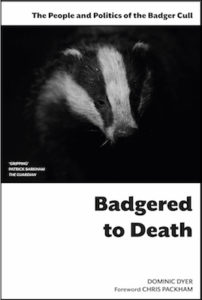What happens when the habitat requirements, the daily activities, indeed the very existence of a charismatic and much beloved animal is perceived to be detrimental to the continued proliferation of an economically valuable one? Well, if the perception in question is that of England’s Department for Environment, Food and Rural Affairs (DEFRA) and the valuable animals in question are cattle, the answer is clear: kill the “troublesome” animals, regardless of however charismatic or beloved they might be.
Such, in a nutshell, is the present situation in England as one of the most scientifically questionable and repeatedly bungled wildlife management schemes in modern history continues to play out: the badger cull. And yet while this long-running wildlife management debacle regularly assures readership to both print and online news sources alike, it had been a bit difficult to understand fully – even for those who regularly follow its developments. However since the publication of Dominic Dyer’s Badgered to Death; the People and Politics of of the Badger Cull, the entire history, as well as the backgrounds of the key players and their respective roles, can be discovered in a mere few hours.
First and foremost, it must be made clear: Dyer is not an indifferent by-stander to the subject. Originally a civil servant with the Ministry of Agriculture, Fisheries, and Food (MAFF) and then a lobbyist with the Food and Drink Federation, he had his moment on the proverbial road to Damascus in 2012 and has since been a tireless campaigner for wildlife, a policy advisor to the Born Free Foundation, and – most relevant to this present topic – chief executive of The Badger Trust. Needless to say, what he writes in Badgered to Death isn’t exactly what could be called objective – however that doesn’t by any means indicate that what he has written isn’t quite likely correct.
Passionate, frank, and at times even startlingly candid, Dyer begins Badgered to Death with a short overview of the badger, Meles meles, in English culture. However he quickly turns to the book’s main topic with a recounting of the beginning of the whole affair back in 1971 when, during an outbreak of bovine tuberculosis on a farm in the Cotwolds, a dead badger found in the area by a MAFF veterinary officer was discovered to have had the disease. Over the course of the following few months one in five badgers in the area were also found to have had it. The question was did the TB in the cattle have anything to do with the TB found in the badgers?
Bovine tuberculosis, Mycobacterium bovis, is, despite its name, not a disease solely visited upon cattle; badgers, deer, pigs, foxes, hedgehogs, and even domestic cats can all be infected by it. Which is why some quickly began asking questions regarding which animals had it first, which had transmitted it to others, and even if the outbreaks in the two different species afflicted by it in the Cotswolds were even related.
The problem, as might be imagined, was that the welfare of the badgers – prominent as they might have been in English culture, particularly as characters in literature – didn’t really have much of a chance when juxtaposed against the health of the British beef industry. TB was in the cattle, TB was in the badgers; the course of action was clear – the badgers had to go.
Thus began the on again, off again, on again (again) decades long saga of the badger cull. Despite – as Dyer describes it – scant research supporting the need for it and significant studies indicating it being ineffective, poorly managed, and scientifically unsupportable, the cull has not only divided English opinion on issues of wildlife conservation, management, and agriculture, it has – as Dyer explains – quite possibly made matters worse on a variety of levels. Indeed, if one of his assertions is correct, the government’s management of the aftermath of an outbreak of a different (and wholly badger unrelated) cattle-afflicting disease, foot-and-mouth, may have even made the occurrence of TB in English cattle more widespread.
Make no mistake – as a life-long denizen of countryside myself, I have tremendous sympathy for any farmer who thinks his or her livelihood is in jeopardy. It’s understandable that those who are losing cattle to TB would be upset when told by officials that the nearby badgers were the cause of their woes. The problem is that, given what Dyer outlines in this book, the line between TB in badgers and TB in cattle isn’t a straight one, or a clear one, and it might even be pointing in the opposite direction than originally thought.
The intricacies, twists, and turns of the cull’s history, as well as the actions of the people, government agencies, and organizations involved in (or in some cases turning a blind eye to) it, are best left to Dyer to explain in the book. And while at times its need for a better proof reader can be momentarily distracting, it is thoroughly compelling from beginning to end. For all those wanting to get behind the newspaper or news website headlines and obtain for themselves a more detailed, nuanced, and comprehensive understanding of the cull, Badgered to Death should be considered essential reading, both for the story its author recounts as well as for the wealth of references to further materials to explore that it contains.
 Title: Badgered to Death: The People and Politics of the Badger Cull
Title: Badgered to Death: The People and Politics of the Badger Cull
Author: Dominic Dyer; introduction by Chris Packham
Publisher: Canbury Press
Format: Paperback
Pages: 240 pp.
ISBN 9780993040757
Published: August 2016
In accordance with Federal Trade Commission 16 CFR Part 255, it is disclosed that the copy of the book read in order to produce this review was provided gratis to the reviewer by the publisher.
